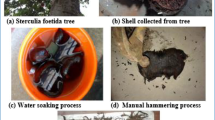Abstract
The global focus on sustainable materials has intensified with the implementation of rigorous regulations aimed at reducing the use of harmful substances. In response to this global trend, researchers are actively promoting the development of environmentally friendly materials, placing a specific emphasis on natural fiber composites (NFCs) for sustainable applications. This study represents the inaugural effort to fabricate and characterize Myriostachya wightiana stem fiber composite. Fourier transform infrared analysis of the fiber indicates the presence of cellulose (O = H), hemicellulose (C = O), and wax (C≡C). X-ray diffraction reveals a crystallinity size and crystalline index of 3 nm and 54% for the fiber. Thermogravimetric analysis reveals activation energy (130 kJ/mol) and working temperature (up to 352.54 °C) of the fiber. The scanning electron microscope reveals surface features of the fiber. The present study explores the tensile and flexural properties of MWSF/epoxy composites in comparison to a four-layer jute composite and their hybrid counterpart. The findings indicate that the four-layer short fiber composite exhibits the good tensile strength (26.917 MPa), while the bidirectional woven fiber mat composites (MbMb [0, 90]) demonstrate a high tensile modulus (1.062 GPa). Among all composites, MbMb [0, 90] and JbMrMrJb composite demonstrate the highest flexural strength (64.815 MPa) and flexural modulus (3.019 GPa), respectively. These findings underscore the potential of these composites for durable and sustainable applications.








Similar content being viewed by others
Data Availability
All data supporting this study are included within the article.
References
Andrew JJ, Dhakal HN (2022) Sustainable biobased composites for advanced applications: recent trends and future opportunities – a critical review. Composites Part C: Open Access 7:100220. https://doi.org/10.1016/j.jcomc.2021.100220
Broido A (1969) A simple, sensitive graphical method of treating thermogravimetric analysis data. J Polym Sci Part A‐2: Polym Phys 7(10):1761–1773. https://doi.org/10.1002/pol.1969.160071012
French AD, Santiago Cintrón M (2013) Cellulose polymorphy, crystallite size, and the Segal Crystallinity Index. Cellulose 20:583–588. https://doi.org/10.1007/s10570-012-9833-y
Global Market Insights (2023) Jute market size & share | Global statistics report 2032. https://www.gminsights.com/industry-analysis/jute-market
Karimah A, Ridho MR, Munawar SS, Adi DS, Damayanti R, Subiyanto B, ... Fudholi A (2021) A review on natural fibers for development of eco-friendly bio-composite: characteristics, and utilizations. J Mater Res Technol 13:2442–2458. https://doi.org/10.1016/j.jmrt.2021.06.014
Li M, Pu Y, Thomas VM, Yoo CG, Ozcan S, Deng Y, ... Ragauskas AJ (2020) Recent advancements of plant-based natural fiber–reinforced composites and their applications. Compos Part B: Eng 200:108254. https://doi.org/10.1016/J.COMPOSITESB.2020.108254
Maharana SM et al (2019) Effect of fiber content and orientation on mechanical properties of epoxy composites reinforced with jute and Kevlar. Mater Today Proc. https://doi.org/10.1016/j.matpr.2019.11.239
Maharana S, Pandit M, Pradhan A (2020) Effect of chemical treatment and fumed silica coating on tensile and thermogravimetric properties of jute yarn. Materials Today: Proceedings 27:2693–2698. https://doi.org/10.1016/j.matpr.2019.12.184
Maharana SM, Pandit MK, Pradhan AK (2021) Influence of fumed silica nanofiller and stacking sequence on interlaminar fracture behaviour of bidirectional jute-kevlar hybrid nanocomposite. Polymer Testing 93:106898. https://doi.org/10.1016/j.polymertesting.2020.106898
Mahir FI, Keya KN, Sarker B, Nahiun KM, Khan RA (2019) A brief review on natural fiber used as a replacement of synthetic fiber in polymer composites. Mater Eng Res 1(2):86–97. https://doi.org/10.25082/MER.2019.02.007
Parida PK, Pandit MK, Pradhan AK (2023) Extraction of natural cellulosic fiber from Myriostachia wightiana stems using chemical retting and its characterization for bio-composite applications. Cellulose 30(14):8819–8837. https://doi.org/10.1007/s10570-023-05438-8
Parida PK, Alam MI, Ghosh R, Pradhan AK, Pandit MK, Maharana SM (2024) Thermo-mechanical characterizations and erosion wear studies of fumed silica-reinforced jute/epoxy composites. J Reinforc Plast Compos 07316844241243152. https://doi.org/10.1177/07316844241243152
Preethi MS, Ramya CH, Sumathi G, Mounika N Sateesh N (2022) Investigations on mechanical properties of jute fiber and epoxy resin composites with titanium oxide. Materials Today: Proceedings 62:4310–4315. https://doi.org/10.1016/j.matpr.2022.04.812
Rangappa S M, et al (2022) Lignocellulosic fiber reinforced composites: progress, performance, properties, applications, and future perspectives. Polym Compos. https://doi.org/10.1002/PC.26413
Sanjay MR, Madhu P, Jawaid M, Senthamaraikannan P, Senthil S, Pradeep S (2018) Characterization and properties of natural fi ber polymer composites : a comprehensive review. J Clean Prod 172:566–581. https://doi.org/10.1016/j.jclepro.2017.10.101
Sanjay MR, Siengchin S, Parameswaranpillai J, Jawaid M, Pruncu CI, Khan A (2019) A comprehensive review of techniques for natural fibers as reinforcement in composites: preparation, processing and characterization. Carbohydr Polym 207:108–121. https://doi.org/10.1016/j.carbpol.2018.11.083
Scherrer P (1918) Bestimmung der Grosse und inneren Struktur von Kolloidteilchen mittels Rontgenstrahlen. Nach Ges Wiss Gottingen 2:8–100. http://eudml.org/doc/59018
Segal L et al (1959) An empirical method for estimating the degree of crystallinity of native cellulose using the X-ray diffractometer. Text Res J. https://doi.org/10.1177/004051755902901003
Senthamaraikannan P, Kathiresan M (2018) Characterization of raw and alkali treated new natural cellulosic fiber from Coccinia grandis. L. Carbohydr Polym 186:332–343. https://doi.org/10.1016/j.carbpol.2018.01.072
Singh S, Agarwal C, Panwar NL, Upadhyay V (2023) Experimental investigation of jute fabric/nano-SiO2 reinforced epoxy composite. J Nat Fibers 20(1):2181264. https://doi.org/10.1080/15440478.2023.2181264
Sydow Z, Bieńczak K (2019) The overview on the use of natural fibers reinforced composites for food packaging. J Nat Fibers 16(8):1189–1200. https://doi.org/10.1080/15440478.2018.1455621
Acknowledgements
The authors express their gratitude to Mr. MD. Irquam Alam for their assistance in tensile testing.
Author information
Authors and Affiliations
Contributions
Pramod Kumar Parida conducted sample preparation, experimentation, and mechanical characterization, with result analysis. Sasidhar Pentapati handled composite fabrication. The initial manuscript draft was prepared by Pramod Kumar Parida, while Arun Kumar Pradhan conceptualized, reviewed, and edited it. All authors reviewed and approved the final manuscript.
Corresponding author
Ethics declarations
Competing Interests
The authors declare no competing interests.
Consent to Participate
Not applicable.
Consent for Publication
Not applicable.
Additional information
Publisher's Note
Springer Nature remains neutral with regard to jurisdictional claims in published maps and institutional affiliations.
Rights and permissions
Springer Nature or its licensor (e.g. a society or other partner) holds exclusive rights to this article under a publishing agreement with the author(s) or other rightsholder(s); author self-archiving of the accepted manuscript version of this article is solely governed by the terms of such publishing agreement and applicable law.
About this article
Cite this article
Parida, P.K., Pentapati, S. & Pradhan, A.K. Thermomechanical Characterization of Myriostachya wightiana Stem Fiber (MWSF)/Epoxy Composite: A Sustainable Material. Mater Circ Econ 6, 22 (2024). https://doi.org/10.1007/s42824-024-00115-y
Received:
Revised:
Accepted:
Published:
DOI: https://doi.org/10.1007/s42824-024-00115-y




